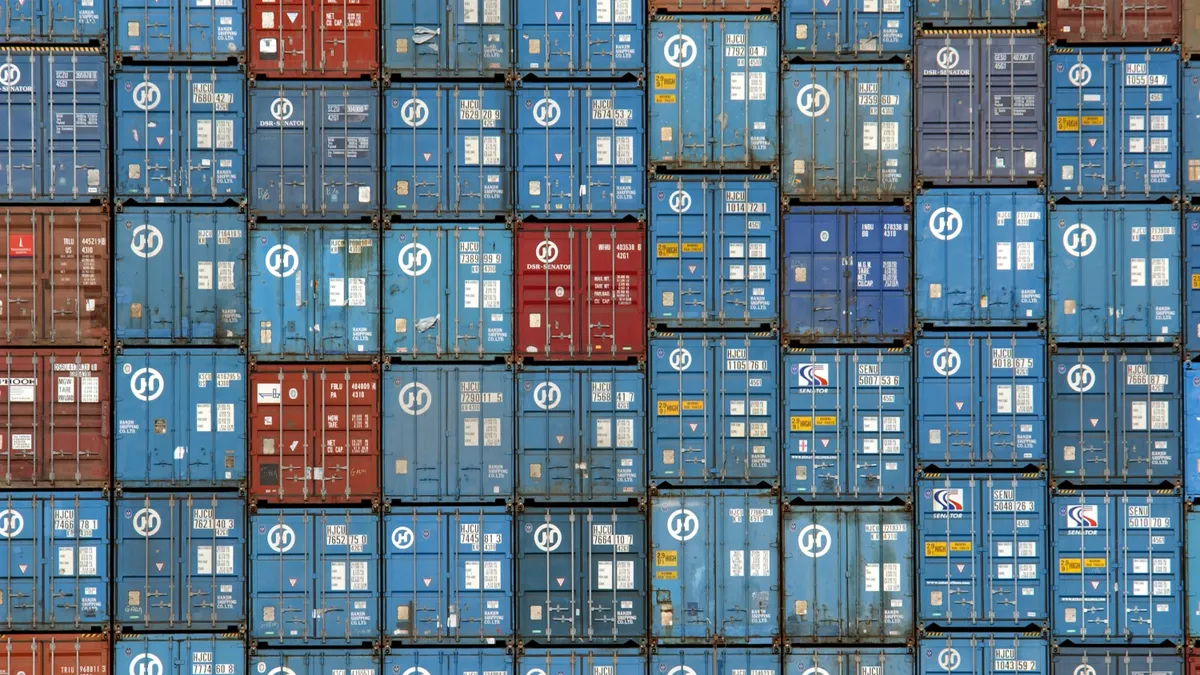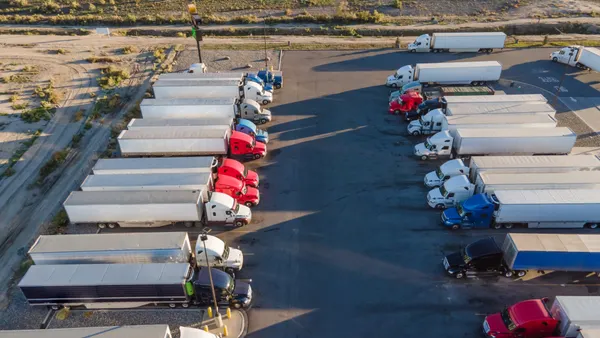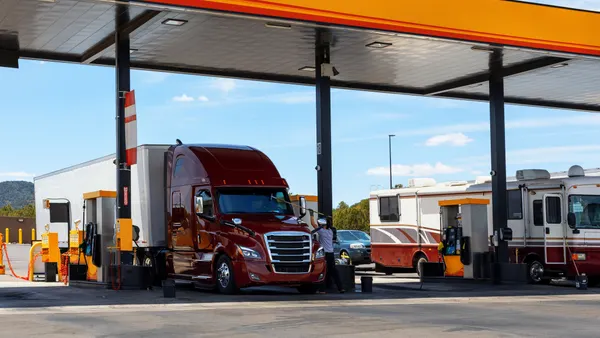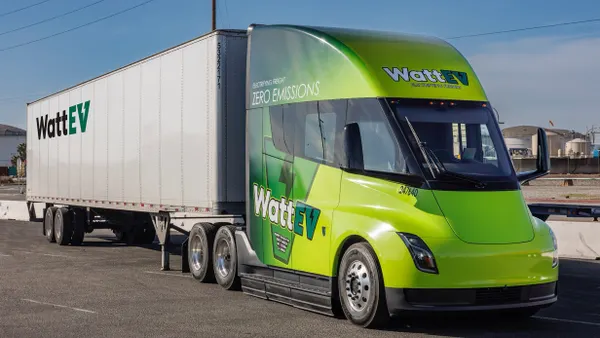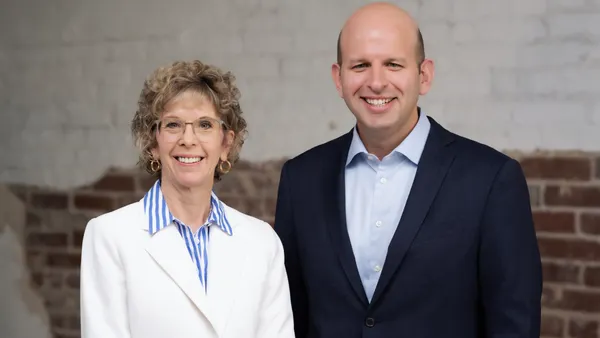The American Trucking Associations' Management Conference & Exhibition last month in Nashville was the first time that in-person event had occurred since 2019. Timing was critical, as the federal government had recently shined a national spotlight on the already-hot topic of supply chain.
With the ATA convening its committees and decision-makers flying into Nashville from across the country, a multitude of topics were up for discussion. The Transport Dive team spent the event sitting in on educational sessions, listening to keynotes and chatting with attendees.
Here are the biggest takeaways of each Transport Dive team member:
Senior Reporter Jim Stinson: The cannibal comparison
Businesspersons like to use the term "cannibalization" to describe a trend in which new business is founded by raiding old business. I heard that term a lot at MCE. Fleets were talking about the cannibalization of their own trucks to feed other trucks, so to speak, because of a parts shortage.
This isn't new for trucking. But in the days of easy access to parts, it was rare to hear about it.
Not so for other industries such as commercial real estate, where developers might cannibalize an old building they own by luring tenants to sign leases for a new building the developers plan. I have seen this happen, but the old building usually offers cheaper leases, so it eventually lures new clients interested in the more affordable rates.
Cannibalization is, thus, always seen as a business risk, even if it must proceed. But I never thought I'd see a serious trend in trucking.

Cannibalization is, thus, always seen as a business risk, even if it must proceed. But I never thought I'd see a serious trend in trucking. From time to time, you will see a movie about doomsday or Armageddon in which working cars and trucks are rare, and parts and gasoline must be taken from old models. Remember "The Road Warrior" from 1982?
This year is the closest I have seen things come to that scenario since the movie. OEMs were still behind on production for Class 8 trucks and other models. Then came the computer-chip shortage and snarled ports. It means fleets are not just short on new and used trucks. It also means parts-makers are behind.
Fleets can run for a long while on the trucks they have now, but they need access to parts and replacement tires, almost every day. Those parts are getting harder to find. Some fleets have taken to poking around on eBay, or driving to distant rural stores.

During one MCE presentation with ATA Chief Economist Bob Costello, Cari Baylor of Baylor Trucking said her company is cannibalizing its own fleet for parts at a higher rate than normal. Normally, Baylor said, 10% of the fleet are available for "swaps" of parts. Now it is up to 15%, said Baylor, leaving some trucks looking like "a Mr. Potato Head." And if fleets like Baylor Trucking have to do that, that means some of the Mr. Potato head trucks have to come off the road, creating more of a capacity crunch.
The supply chain problems causing havoc with parts is the one topic that struck me the most at MCE. It's one supply chain problem that has to be fixed, relatively soon, or we will see sustained spot prices and possible shortages of goods well into 2022.
Dive deeper:
- Carriers use everything but rubber bands to keep fleets running
- Fleets weigh convenience against customer service in online parts procurement
Managing Editor Andy Burt: Trucking's 3 gaps
Traveling to Nashville with the Transport Dive team, our first in-person adventure since the publication launched in early 2020, was an illumination of where the industry lies at present. Other industries have certainly struggled to discern how to evolve from an older world of pre-cell phone "technology" and computers the size of a semi-trailer. But trucking, in particular, has its roots (and routes) laid in the horizontal plane, and that will never cease to be.
As the truck metaphorically moves across the landscape, farther from its origins in search of a place to unload and rest, I observed three gaps.
1. The driver supply gap
This gap is no surprise to anyone, including people way outside of this industry. It is a simple question of supply and demand — when you have more goods moving across the country than ever before, and you have a perpetual deficit of qualified drivers to transport those goods, the outcome is scarcity. The gap and the turnover has remained constant since I've begun covering the supply chain space generally. Costello now argues the driver shortage is around 80,000.
With population and demand for goods ever-rising, this gap only gets worse unless something structural changes in the equation. Does the structure get disrupted by changing the rules? Maybe. But how does changing the rules affect a change on the culture as a whole, one which does not esteem the driver? Therein lies the real problem.
2. The technology gap
Over the course of two days at MCE, I talked with numerous people who didn't grow up in trucking, but in computer science, cloud computing and mechanical engineering. They are building truly amazing and transformative things. And as smart and driven as they are, and in all the ways they can build new tech that can evolve the industry, there is still a gap between new ideas and ancient mechanics.
This is not an uncommon problem across the board, as various industries seek to evolve in a way that meets new demand by an expanding population, while simultaneously making said industry desirable enough for people to want to participate in it (see No. 1).
There was a time when cars were made out of wood. And some companies, such as the Morgan Motor Co., still build them this way. Why? Galileo once famously said, "e pur si muove"; translated: "and yet it moves." The old way still works.
3. The energy gap
By this I do not mean the question of fossil fuels or hydrogen cells or electricity — my Transport Dive teammates can express this better than I — but rather, the momentum and persistence needed to continue to bring about evolution in an industry.
At the top of the leadership mountain are people who have a vision to move forward. They are committed, they are driven and they are very, very smart. They are also optimistically defiant against a wave of new economies that would love, on some level, to leave behind the trucking industry in search of better means for carriers to thrive.
The gap isn't mechanical or technical, but cultural.

But as long as there are some 3,000 miles in between the coasts of the continental U.S., there will be a need for trucks, regardless of how many or how few pieces of technology reside inside of the tractors and trailers.
And so the gap isn't mechanical or technical, but cultural. The industry faces this gap between the leaders who want to navigate into the future, and a cadre of drivers (and lack, thereof) who can't yet see themselves in a future that is interesting and worth pursuing. The challenge of progress against ancient travel and transport is, therefore, extremely personal.
Dive deeper:
- ATA's Costello: Trucking alone can't solve the 80K driver shortage
- Driver concerns are trucking's top issues in 2021: ATRI
- Why former UPS, FedEx execs say AI will be the standard for transport
- LTL carriers upgrade service centers for the future
Editor S.L. Fuller: Diversity as an existential topic
Is trucking going in the right direction, or is the industry ripe for the next generation to come in and significantly shake things up?
That's a question I submitted to a panel featuring four Lead ATA participants and graduates, moderated by Yellow CEO Darren Hawkins.
"I think that we're making a lot of progress. But I think that there are significant changes that we're going to have to make," said Mezzalina Dejongh, a branch manager at Trimac Transportation and 2019-2020 graduate of Lead ATA.
Those changes have to do with industry "accessibility," as she put it. At the heart of the issue is diversity in recruitment, attracting people who may never have thought trucking could be a fit for them.
.@Yellow_Trucking CEO Darren Hawkins speaking with the industry's emerging leaders about the issues on trucking's horizon and what we need to grow and thrive in the years ahead. #ATAmce21 https://t.co/h2weMvdHM8 pic.twitter.com/kfSYr3N4h6
— American Trucking (@TRUCKINGdotORG) October 24, 2021
Panelists could have taken my question in any direction. But the topic of workforce diversity was an undercurrent of the whole conference. Freightliner even sponsored a diversity and inclusion seminar led by the general manager of marketing at Daimler Trucks North America.
Yes, much of the interest stems from the driver shortage, which is top of mind for most. But broader discussions about diversity went beyond the immediate need for butts in seats.
From what I gathered, diversity, equity and inclusion is viewed by the industry as somewhat of an existential subject. Can trucking reposition its image to be more inclusive and foster diversity in the workforce, so that it may continue to grow, modernize and be competitive?
President and CEO of Trailiner Corporation Amber Edmondson, a 2018-2019 Lead ATA graduate, phrased it as expanding "outside of our trucking bubble" to appeal to workers headed for different industries that directly compete with transport for labor.
Can trucking reposition its image to be more inclusive and foster diversity in the workforce, so that it may continue to grow, modernize and be competitive?

Multiple panelists agreed that part of the solution is reaching young people in schools. Dejongh emphasized doing outreach at the high-school level or younger. Brandon Bibbs, regional vice president of sales for U.S. Xpress and member of the Lead ATA 2021 class roster, noted the importance of leaning on diverse talent to go into those schools and recruit diverse talent.
The lack of interest in the trucking industry from people with diverse backgrounds partly stems from the fact that "they're not seeing folks that look like them — you know, younger people, people of color, women," he said.
But, he added, the industry is headed in the right direction. His presence as a Black man on stage in that panel was proof, he said.
Dive deeper:
- How 3 fleets recruit, retain and move women up the ranks
- Trucking, like the nation, examines itself for racial bias
- Focus on workplace allyship, inclusion efforts can boost retention: study
Lead Editor Shefali Kapadia: Trucking alone didn't congest the supply chain, nor will it decongest it
A truck guy, a rail guy and an ocean guy walk into a bar — except the bar is the stage of ATA's MCE.
I expected finger pointing at shippers for not unloading quickly enough, a punchline about railroads moving too slowly, or a blame game centered on trucking firms avoiding drayage operations like the plague. Surely, there was bound to be an argument about who worsened the congestion the most.
My expectation could not have been more wrong.
"We're all in this together," said Ian Jefferies, president and CEO of the Association of American Railroads. "When any piece of the supply chain isn't able to operate at full capacity, it has reverberating impacts. ... Things tend to get kinked up."
ATA President & CEO Chris Spear joins @AAR_FreightRail’s Ian Jefferies, @WSC_shipping’s John Butler, @NASSTRAC’s Gail Rutkowski, & @Shelley_Simpson of J.B.Hunt to discuss multimodal solutions to today’s supply chain challenges. #ATAmce21 pic.twitter.com/zmBCw68Fdy
— American Trucking (@TRUCKINGdotORG) October 25, 2021
The togetherness of the supply chain has been one of the main themes as the West Coast ports transition to 24/7 operations. A port open at night only works if terminals, warehouses, railroads and trucks also operate at night.
Jeffries and ATA CEO Chris Spear were quick to point out that railroads and trucks have operated 24/7 since long before the pandemic-induced congestion.
"It's nice to see them join," Spear quipped, referring to the West Coast ports.
The panelists called the 24/7 transition an encouraging step and emphasized that they're all working hard together to ease the port bottlenecks.
The groups on stage — associations representing trucking firms, railroads, ocean carriers and shippers — all have a vested interest in making sure cargo flows. For the carriers, it's a simple math equation: more velocity = more freight in transit = more revenue. And for shippers, it's a better guarantee of inventory and sales.
But for other stakeholders involved in the 24/7 transition, I'm not so sure. What motivation does a terminal have to stay open longer hours? Does a chassis lessor benefit from pooling resources and allowing interoperability? Why would a warehouse operator choose to remain open, hire more workers and keep the lights on into the night?
Is the greater good of solving supply chain congestion enough to get all parties on board?

This is why trucking alone can't solve congestion. Adding more drivers or suspending HOS only solves a few symptoms of the problem. It doesn't fix appointment struggles, lines the length of Wimbledon queues or load/unload speeds at warehouses.
Is the greater good of solving supply chain congestion enough to get all parties on board?
The panelists were cautiously optimistic about the transition to 24/7, and so am I. Jeffries summed it up best, in my view.
"It's a positive step," he said. "It's not a panacea."
Dive deeper:


